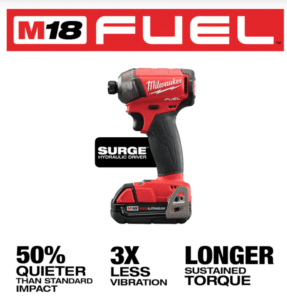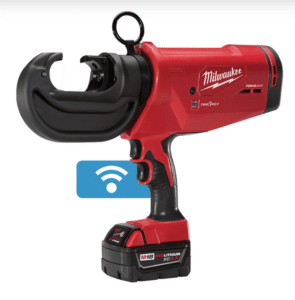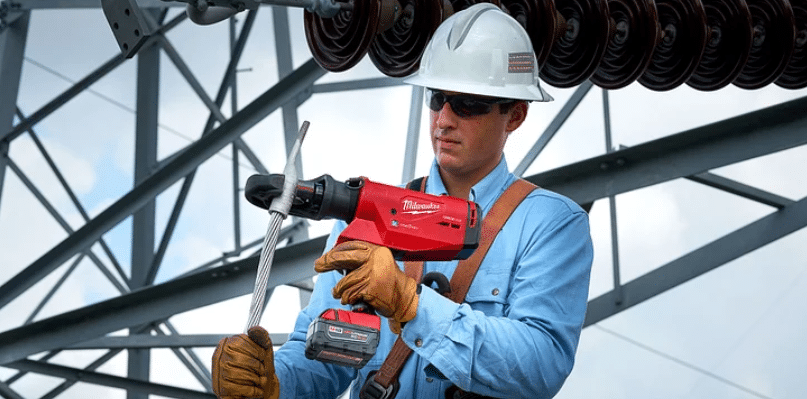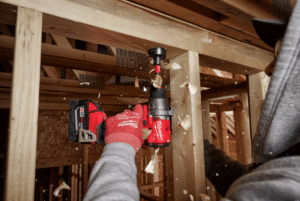Power tools are bridges between the worker and the work, the points from which force is generated and applied toward the completion of a task. If power tools are not designed with thought and care, that force can reverberate backward instead of outward, causing damage to the user.
There’s a word for the kind of thought and care we’re talking about, a word that guides the design of the industry’s safest and easiest to use power tools. That word is ergonomics.
In this article, we will explain what ergonomics is, why it’s important in power tools, and how Milwaukee Tool approaches ergonomics in the design of our power tools. Then we will explore some of the features that go into the design of an ergonomic power tool and discuss how ergonomically designed power tools can reduce the risk of musculoskeletal disorders. Finally, we will showcase two examples of Milwaukee’s most ergonomically designed power tools.
What Is Ergonomics? Ergonomics Definition
Ergonomics is the “science of work.”
Derived from the Greek words for “work” (ergon) and “laws” (nomos), ergonomics is defined by the International Ergonomics Association (IEA) as:
“the scientific discipline concerned with the understanding of interactions among humans and other elements of a system, and the profession that applies theory, principles, data, and methods to design in order to optimize human well-being and overall system performance.”
A bit of a mouthful, right?
The Occupational Health and Safety Administration has a more elegant version, defining ergonomics as:
“…the science of designing the job to fit the worker, rather than physically forcing the worker’s body to fit the job.”
Designing the job to fit the worker involves the creation of work processes and tools that reduce stress on a worker’s body and eliminate certain types of injuries like musculoskeletal disorders (we’ll talk more about those in a moment).
Why Is Power Tool Ergonomics Important?
Construction workers use power tools everyday for hours at a time. This is what makes ergonomic power tools and ergonomic construction tools so critically important: When a worker has an ergonomic power tool in their hands, they are less likely to be injured or fatigued, and are therefore able to remain productive for longer periods of time.
Milwaukee Tool®’s approach to ergonomics
Ergonomics is central to our design philosophy here at Milwaukee® Tool. Ease and safety-of-use are infused into the DNA of each of our power tools, informing every step of the design process from the moment an idea is put on paper to the creation of the final prototypes.
Ergonomics is an afterthought for some manufacturers, who make the mistake of only evaluating the ease and safety of their products after they’re finished, when it’s too late to make the necessary changes.
Our goal is to create the smartest, most powerful, compact, efficient, and ergonomic power tools in the industry.
To accomplish this, we’ve rested our strategy on three pillars:
- In-house expertise
- Science in power tool ergonomics
- User input about power tool ergonomics
In-house ergonomics expertise
Striking the balance between a tool’s ergonomics and performance is no easy task. To make sure we hit our mark every time, Milwaukee Tool has hired a team of ergonomics experts, including a certified ergonomist, sound and vibration specialists, ergonomics testing engineers, and a variety of other product-use technicians. With their expertise, we are able to ensure that ergonomics is centered as a top priority in each of our products.
Science in power tool ergonomics
At Milwaukee Tool, we leverage cutting edge science to create some of the most ergonomic tools on the market. To that end, we have invested in electromyography (EMG) technology to record the amount of muscle effort that is exerted when a person uses our tools. Armed with this sophisticated source of precise and objective information, we can ensure that ergonomics is baked into our tools from the very beginning.
User input about power tool ergonomics
No one has a better handle on the real-world functionality of a tool than the workers who use them in the field, day-in and day-out. Milwaukee Tool is a leader in this space because we’ve set the input of our users as the North Star of our design process, including surveys and product testing by actual users in our decision-making process.
Ergonomic Power Tool Features
Ergonomic power tools should above else be safe and easy to use.
A power tool can be said to be ergonomic when its design and function are fitted to the worker, optimizing performance while also providing protections against injury and fatigue. There is no formula or magic bullet to guarantee that a power tool is ergonomic. There are, however, a few guidelines and best practices that designers of power tools should consider:
- Weight
- Grip
- Shape
Weight
To be ergonomic, a power tool’s weight should be well-balanced and light enough to allow for reduced muscle strain and comfortable use in a variety of settings.
Grip
Rubberized and textured handles molded to the anatomical structure of a human hand can allow for a firm, comfortable grip while reducing pressure, absorbing vibrations, and accounting for torque. Different types of tools may require different types of ergonomics hand grips for comfortable use, be it a pistol grip for drills, a D-grip for Sawzall®s, or a trigger grip for an angle grinder. Speaking of which, triggers and paddles switches should also be designed to require minimum pressure so as to avoid straining the hand and finger muscles. Extra handles for stabilization can also increase control and more equally distribute force and vibrations.
Shape
Ergonomic power tools are designed to fit the physiology of the human body. They are conscientious of posture, musculature, and human range of motion. A tool’s shape should allow for versatility of use and limit the amount of strain felt in the user’s hands, wrists, and arms.
 Anti-kickback Features
Anti-kickback Features
One of the strongest ergonomic protections a power tool can provide is anti-kickback, an essential feature that is built-in to many of our power tools here at Milwaukee Tool.
The Power Tool Institute defines kickback as the “sudden and interrupted movement of the tool or workpiece [… which is] typically caused by binding or pinching of the workpiece.” Kickback is the second most common cause of injury to workers who use power tools on a regular basis, resulting in sudden rotations that cause broken wrists and tears in the triangular fibrocartilage complex.
Power tools can prevent kickback with features like Milwaukee’s AUTOSTOP™, a machine learning backed safety mechanism that senses and prevents over-rotations and bind-ups, deactivating the drill before an injury can occur. To learn more about AUTOSTOP, check out the M18 FUEL™ ½” Drill/Driver.
How Ergonomics Reduces the Risk of Musculoskeletal Disorders in Construction
We take ergonomics seriously because worker health and safety depend on it.
Remember, construction is one of the most hazardous occupations in the world, with construction workers accounting for one in five of workplace deaths in the US in 2019. That same year, construction workers experienced almost 80,000 injuries, a 23% increase from the year before.
Of those injuries, musculoskeletal disorders are among the most serious and pervasive. Musculoskeletal disorders (MSDs), are a diverse variety of conditions that affect a person’s bones, joints, muscles, nerves, and connective tissues. Sometimes referred to as “ergonomic injuries”, MSDs affect people of all age groups, though they are most common among workers between the ages of 45 and 54, according to the Bureau of Labor Statistics.
MSDs can range from minor pain to chronic and acute conditions with life-altering effects. Any amount of overexertion or strain caused by a task can be the first step on a long road of musculoskeletal pain. A few common MSD diagnoses in the world of construction include:
- Lower back pain
- Tension neck syndrome
- Carpal tunnel syndrome
- Trigger finger
- Ruptured or herniated disc
- Rotator cuff tendonitis
MSDs are among the largest causes of workplace injuries and disabilities, accounting for 33% of all newly reported occupational illnesses in the US. The problem is much more severe in the construction industry, where 77% of all occupational illnesses are an MSD.
This is a worldwide problem. An astonishing 1.71 billion people have a musculoskeletal condition according to the World Health Organization, and the high prevalence among construction workers holds true in nations all over the world. A recent study of construction workers in South Korea, for instance, revealed some startling findings:
- 30.7% of workers experience frequent back pain
- 61.3% experience pain in their upper extremities.
- 49.2% experience pain in their lower extremities.
- 35.6% experience extreme fatigue.
MSDs can occur in any kind of occupation, whether you work in an office or at a grocery store. They’re particularly common in construction, however, because of the physically strenuous nature of the work: Lifting heavy loads, performing repetitive tasks, and the exposure to vibrations from power tools are all risk factors that contribute to the high rate of MSDs in the world of construction.
The impact on the health and safety of construction workers ought to be enough for industry leaders to take MSDs seriously, but they also incur enormous losses of time and money. In 2018, the median days-away-from-work as a result of an MSD was 12, according to the BLS. And every year in the US, direct costs from MSDs are between $15 and $20 billion. When tabulated with indirect costs, that number can climb as high as $54 billion.
There are many things workplaces can do to prevent MSDs, but one of the most effective strategies, according to OSHA, is ergonomics. An essential first step toward achieving a sound “science of work” is to give your workers state-of-the-art tools that have been designed with ergonomics in mind.
Two Examples of Ergonomic Power tools by Milwaukee
Every single one of our power tools is designed with ergonomics in mind. That said, there are a few exemplary standouts.
Let’s take a look at a few of Milwaukee Tool’s most ergonomically designed power tools.
The M18 FUEL™ Surge Hydraulic Driver
An important aspect of ergonomics that often goes overlooked is sound.

With this in mind, Milwaukee’s product design teams routinely conduct highly precise sound tests of our power tools in a fully isolated hemi-anechoic sound chamber. In this highly controlled environment, we can determine the exact decibel levels that our power tools emit and zero-in on design choices that can help bring the sound levels down.
Using this process, we were able to reduce the noise of the M18 FUEL™ Surge Hydraulic Driver by 50%. According to the American Academy of Audiology, humans are at risk of hearing damage when exposed to sounds of over 85 decibels for extended periods of time. We were able to lower the noise output of the M18 FUEL™ Surge Hydraulic Driver to 76 decibels, making it one of the quietest tools of its kind. At its current sound output, a worker can safely use this tool continuously for an 8-hour day without the need for hearing protection.
The M18™ FORCE LOGIC™ 12T Utility Crimper

12T utility crimper Two major causes of musculoskeletal disorders are overexertion and repetitive motions.
Overuse of muscles can lead to fatigue and pain, while the repetition of tasks can cause extreme tissue inflammation that, in some cases, require surgeries to correct. One example is “trigger finger,” an MSD where a person’s fingers get locked in a bent position as the result of repeated gripping, such as the pulling of a trigger on a power tool, for instance.
We solved for this with our 12T Utility Crimper. Using a high-capacity muscle testing system, we were able to design it to require less than eight pounds of trigger release, which is 75% less than other crimpers. Thanks to an improved center of gravity and a significant weight reduction to the tool, it also requires 47% less muscle effort to use.
Bottom Line
We all need to do our part to make construction a safer occupation. Power tool manufacturers have a particularly important role to play. So many injuries can be avoided when power tools are designed with thought and care, when safety and ease of use are centered above all other priorities.
——
Source: Republished with Permission by Milwaukee Tool, Originally Written by Mike Anderson, One-Key Team. Originally Published August 11, 2022.


 Anti-kickback Features
Anti-kickback Features